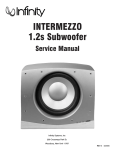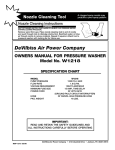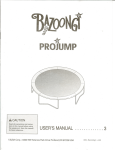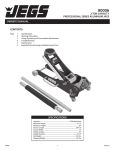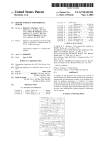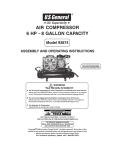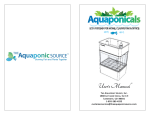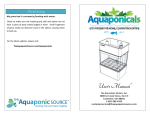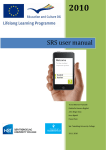Download DBK6272 - Pirate Jack
Transcript
DBK6272 FITS 1962-72 Mopar B-Body, 1970-74 E-Body Disc Brake Conversion Kit * High performance kit shown. Regular kit has plain rotors & hoses. Installation Instructions Note: Always refer to the vehicle owner’s manual for correct torque specifications when installing kit. 27 Mulvaney Street • Asheville, NC • 28803 • Phone: 800-231-4125 • Fax: 828-285-0877 • www.mbmbrakes.com Installation Instructions operation of your brakes is essential for your safety and the safety of others. Warning Proper Any brake service should be performed ONLY by persons experienced in the installation and proper operation of brake systems. It is the responsibility of the person installing any brake component or kit to determine the suitability of the component or kit for the particular application. After installation, and before operating your vehicle, be sure to test the function of the brakes under controlled conditions. DO NOT DRIVE WITH UNTESTED BRAKES! Important Take time to read all the literature that came with this kit. Before beginning installation check the provided list of parts against what you received to ensure that all parts are present. While this kit was designed to make the process of changing brake parts as simple as possible, NOTE: WITH SOME KITS IT MAY BE NECESSARY TO MAKE MINOR CHANGES TO YOUR CAR! READ ALL WARRANTY DISCLAIMERS AND RETURN POLICIES INCLUDED IN THIS KIT PRIOR TO INSTALLATION! Note Always utilize safely restraints when operating the vehicle. The installation of disc brakes will require the use of 15” wheels. Any attempt to install disc brake with a 14” wheel will be the customer’s responsibility. Note This kit is an aftermarket solution. It is not intended to be a direct installation or OEM replacement. Due to changes in production in certain years, your car may require modifications beyond these instructions for this kit to install properly. Page 2 Installation Instructions Parts included with this kit: Part # 2627 BP302D/P BPRP6570 5314 HSDBK-7/16 HWK6272 A1 A2 5121 20618101 4103/4104 PRE104 Description Spindles Backing Plates Booster Bracket Rotors Brake hoses Hardware Kit Inner Bearings Outer Bearings Seals Dust Caps Calipers Pedal Rod Extension Quantity 2 2 2 2 2 1 2 2 2 2 2 PERFORMANCE UPGRADE PARTS: 5314LX/5314RX HSDBKSS-7/16 High performance drilled and slotted rotors Stainless steel braided hoses OPTIONAL PARTS (Not included with kit, available for seperate purchase): Power Booster Master Cylinder Proportioning Valve Kit Vacuum Hose & Fittings Page 3 2 2 Installation Instructions Preparing your vehicle to install your brake system upgrade • • • • • • • Rack the vehicle. If you don’t have a rack, then you must take extra safety precautions. Choose a firmly packed and level ground to jack up the vehicle. Chock the rear wheels. Jack the vehicle up and support it with jack stands and secure the pins. Set the parking brake and put the transmission in park if automatic, reverse if manual transmission. The front wheels should be allowed to free hang to relieve tension on the coil springs. Important NEVER rely on jacks to support a vehicle! Always test the steadiness of your stands that are supporting the vehicle before attempting to work on a raised vehicle! Preparing your parts Figure 1 • Locate the spindles and the inner wheel bearings. In order to install the inner bearings on new spindles, often you must remove .0004” from the inner bearing seating diameter. This can be accomplished with 240 grit emery paper and a rotary sanding motion on the spindle. Be sure to sand around the radius of the spindle which avoids flat spots. Continue this operation Universal Bearing Packer until the inner bearings can be slid onto the spindle without binding. ReJegs # 555-W1218 member to use brake parts cleaner to keep all surfaces free of debris. Also use a lubricant such as bearing grease to ease them on. Do not grind or file on the spindle! • Pack all bearings with hi-temp wheel bearing grease. A bearing packing tool is ideal for the job. (See Figure 1) • Adhere the brake pads into place using disc brake quiet and bend outer brake tabs over calipers accordingly. Let them cure! • Mate up each threaded nut with its’ designated bolt or threaded surface. • Group your kit parts to speed up the installation. • Check your quantity of components versus the items list. Components to inspect, replace or upgrade prior to And / or during installation of disc conversion kits Tie rod ends and nuts Control Arms Upper Ball Joints and nuts Residual valves Brake lines Adjustment sleeves Idler arm and nut Lower Ball Joints and nuts Metering valves Stainless steel brake lines Page 4 Control arm shafts, mounting bolts, & nuts Pitman Arm and nut Shocks and hardware Proportioning valves Stainless steel hardware Installation Instructions Suggestions: • Take the time to identify any suspect parts that are not included in this kit. • Consider making upgrades such as converting to polyurethane bushings, performance shocks, tubular a-arms, etc. • Plan any Installation (s) of replacement parts during the various stages of the drum to disc conversion process. Installation of the disc brake kit will require the use of the following tools & chemicals: Most Tools Available at www.Jegs.com part numbers referenced below. Wheel bearing seal driver Drum brake tool Flare wrench set 3/8” ratchet drive set 3/8” Allen wrench or socket Jack stands 555-W38911 555-80710 555-80036 Box end wrench set Ball joint fork Tire iron 555-W30630 555-80622 555-80581 / 555-80582 Pliers 555-W30715 Universal Bearing Packer 555-W1218 Ball pein hammer Caliper slide grease Screwdriver 555-W80007 Line bending tool 555-80086 Disc brake pad spreader tool Hand cleaner Snips 555-80577 Disc brake quiet Wheel chocks Brake spring pliers 555-W175 Brake bleeder wrench 555-80660 / 55580661 Grease gun 555-W54204 Wheel bearing grease Brake Fluid Brake cleaner Instructions 1. If you are performing the installation with a jack be sure that the parking brake is set and that the rear wheels are chocked. Support the front of the vehicle with jack stands. Never work on sloping ground. 2. If you’re using a lift, raise the vehicle to a comfortable working height. 3. Remove the front wheels. 4. At this point, be sure to place the proper support under the lower control arm. Failure to do so will allow the coil spring to blow out when the spindle is removed which could result in serious Injury and damage to the vehicle. 5. Utilizing a mallet and screwdriver, remove the brake hose clip at the frame bracket by tapping it loose. Disconnect the brake hose from the hard line using the appropriate flare wrenches. 6. Locate the ball joint at the tie rod end and the steering arm. Remove the cotter pin and loosen the ball Joint nut approximately 1/2 off. This allows for a controlled, separation of the tie rod end and the steering arm. Place the balk joint fork between the steering arm and the ball joint. Strike the fork with a mallet until the steering arm and ball Joint separate. Remove the ball joint nut. 7. Repeat the process described in step 6 for the lower and upper ball joint at the spindle. Place the ball joint fork between the spindle and the ball joint. 8. Slowly lower the support and remove the drum brake assembly as a unit. 9. Inspect the ball joints for signs off excessive wear and check to see if the rubber boot Is torn. If the ball Joint wobbles excessively or is worn, now is the time for replacement. Clean the ball joints with a rag. Keep the lower ball joint and steering arm assembly because it will be reused in this installation. 10.Take the drum brake assembly to a bench to disassemble it. Remove the dust cover by twisting a screw- Page 5 Installation Instructions driver between the dust cover and the hub. Remove the cotter pin and take off the spindle nut. Save the spindle nut and the keyed washer to use on the disc spindle. Remove the bolts that hold the steering arm to the spindle and retain the arm and the bolts to use on the disc spindle. (This requires removing the brake shoes which is easier with a drum brake tool.) 11.Bolt the old steering arm ball joint assembly to the new disc brake spindle as shown below. Passenger Side Spindle Bolts Front of Car 12.Now assemble the caliper bracket to the spindle with the 1 1/2’’ bolts supplied with the spindles. Passenger Side Front of Car Page 6 Installation Instructions Figure 4 13.Now install the inner bearing (the larger bearing) and bearing seal into the rotor as shown below. Carefully tap the bearing seal into place securely with a small hammer or large socket. Be sure to grease the bearings before installing. Tech Advisory: 60’s used left hand thread wheel studs on the driver side, change studs if necessary 14.Install the rotor onto the spindle followed by the outer bearing. Re-use the old spindle nuts and washers. Tighten the spindle nut until the rotor does not spin freely and then back off the nut slightly until the rotor spins freely but does not wobble. Secure with cotter pin. Install the dust cap. 15.After the spindle is on the rotor place the inboard disc pad into the caliper cradle. Grease the caliper slides. Now drop the caliper onto the cradle with the outboard pad on the other side of the rotor so the pads sandwich the rotor between them. (See detailed Single Piston Sliding Caliper instructions on the next page) Page 7 Installation Instructions 16.Secure the caliper to the bracket with the supplied clips as shown. The larger clip goes on first followed by the smaller clip. Bleeders screws up! 17.The assembled spindles will be bolted to the vehicle in reverse of the removal of the drum spindles. Attach the pre assembled disc kit onto the lower control arm bolt. Snug the nut. (check the service manual for the specified torque value) Add the cotter pin. 18.Pop on the new upper ball-joint boot- or the old one if you didn’t destroy it and raise the control arm until the tension is removed from the shock so you can get the upper and lower ball joints in without stress. Again, remember the torque specs and the cotter pins. Connect the tie rod and the new brake hoses that came with the kit. Run the hoses to the frame and connect to the hard line where the drum hoses were attached. Remember this: you will need to get a wheel alignment. Page 8 Installation Instructions Single Piston Sliding Caliper “O” Ring Installation The “O” ring, packaged in hardware kits, prevents the rattle by limiting the end movement of the caliper. It is installed as follows: 1. Before inboard shoe or caliper is installed, place the “O” ring around the adapter upper way as shown in this illustration. 2. Install inboard pad in the adapter. 3. Lower the caliper into the adapter upper way so that the “O” ring is compressed into the chamber and end clearance area. Rotate the caliper down and move it into place on the adapter lower way. 4. Install the retaining plates with the inboard shoe anti-rattle springs on top of the plates, underneath the bolt heads. Torque retaining bolts to 200 inch pounds. NOTE: The “O” ring may break after the vehicle has returned to service. This should be of no concern, as the portion of the “O” ring which is effective in eliminating rattle will remain in place between the caliper and adapter. Figure 1 Page 9 Installation Instructions Caliper Removal 1. Remove wheel and tire assembly. 2. Remove caliper retaining clips and anti-rattle springs (Fig. 1, previous page) 3. Remove caliper from disc by slowly sliding caliper assembly out and away from rotor. 4. Remove inboard shoe from adapter. 5. Remove outboard shoe by prying between shoe and caliper fingers. 6. To remove piston, support caliper assembly on upper control arms on shop towels to absorb any hydraulic fluid loss. Carefully depress brake pedal to hydraulically push piston out of bore (brake pedal will fall away when piston has passed bore opening) Prop brake pedal to any position below the first inch of pedal travel to prevent loss of brake fluid. 7. Disconnect flexible brake hose from caliper. Caliper disassembly 8. Mount caliper in a vise equipped with protector jaws. Caution: Excessive vice pressure will distort caliper. 9. Remove and discard boot and seal. Use pointed wood or plastic stick to remove seal as metal tool may scratch piston bore or burr edge of seal groove. Cleaning and Inspection 10. Check piston bore for scoring and pitting. Bores with light scratches or corrosion can be corrected with crocus cloth. Deep scratches or scores may be removed by honing providing diameter of bore is not increased more than .002”. Replace caliper if not within specification or is cracked. 11. Inspect piston. Replace if pitted, scored of plating is severely worn. 12. Clean caliper and piston with alcohol or brake fluid and blow dry. If caliper was honed, carefully clean seal and boot grooves and flush with clean brake fluid. Wipe dry with clean, lintless cloth. Repeat flushing, until clean cloth shows no sign of discoloration. 13. Remove any rust or corrosion from machined surfaces of caliper or adapter. 14. Clamp caliper in vice with protective jaws. 15. Coat new piston seal and piston bore with brake assembly fluid and install seal in groove in bore. 16. Coat new boot with brake assembly fluid and install in caliper. Slide finger around inside of boot to make sure It is fully seated. Figure 2 Figure 3 Page 10 Installation Instructions 17. Plug high pressure inlet to caliper, then coat piston with brake assembly fluid. With fingers spreading boot, work piston into boot and press down on piston. The entrapped air below piston will force boot around piston and into its groove as piston is depressed. Remove plug and carefully push piston down until it is bottomed. (Fig. 2) 18. Install new outboard shoe. No free play should exist between brake shoe flanges and caliper fingers. (Fig. 3) Caliper Assembly If free play is evident, remove shoe from caliper and bend flanges (Fig. 4) to create slight interference fit to eliminate all vertical free play which might cause shoe rattle. Install by snapping shoe into place with fingers or with “C” clamp using old pads over new lining and across caliper fingers (Fig. 5). 19. Install new inboard shoe in position on adapter with shim “flanges” in the caliper “ways”. 20 Carefully slide caliper into position in adapter and over disc. Align caliper on machined ways of adapter. Be careful not to cut or pull dust boot from its groove as the piston and boot slide over the Inboard shoe. 21 Install anti-rattle springs and retaining clips and torque retaining screws to 180 inch-pounds. NOTE: The inboard anti-rattle spring must always be installed on top of the retainer spring plate. 22 Reinstall brake hose and unblock brake pedal. 23 Fill master cylinder reservoir, if necessary, with clean disc brake fluid and bleed the hydraulic system. Check for fluid leaks under maximum pedal pressure Figure 4 Page 11 Figure 5 Installation Instructions Important INFO regarding Firewall plate: This booster bracket is intended for use when adding disc brakes to your manual brake car. If your firewall plate is the same as the manual plate shown then proceed with the instructions If you are updating your original factory power brake system with this kit then you will need to modify the firewall plate in order for proper connection between the pedal and pedal linkage. Please refer to example for detail on the modification required to the original plate for use with this kit. The kit WILL NOT install correctly without this modification. A&B-BODY PLATE E-BODY PLATE Important POWER POWER MANUAL If attempting to use this kit with an original power brake car you will need to modify the firewall plate as shown in this figure. This will allow enough clearance for the pedal linkage to operate properly. This modification can be avoided by replacing your plate with a manual plate. You may want to cover the open section not covered by the boot adaptor by welding or riveting material in place. This will prevent problems with heat and dust. EXAMPLE Remove this section of the power brake firewall plate for proper operation. MANUAL Important You must also move the hanger studs on the 2. Re-locate studs to here. original power firewall plate, in order for it to work properly with this kit. Thread a nut onto the end of the stud to protect the threads and then knock it loose from it’s seat with a hammer. Then remove the studs and relocate 1. Remove studs from here. them to the upper holes in the firewall plate. Bracket INSTALLATION Page 12 B C 3 3 1. Disconnect the master cylinder push rod from the pedal inside the vehicle. 2. Remove the brake lines from the old master cylinder. 3. Remove the old master cylinder. (please see previous page if converting from manual configuration to power configuration). Remove the pushrod from the brake pedal by removing the bolt located at the top of the pedal (arrow A). There are four bolts that you need to 3A Installation Instructions remove in order to pull the master cylinder off. Two of them (arrows B and C) are easy to see and get to; the other two located on the opposite side of the firewall can be difficult to get to. Figure 6. 4. Insert pedal linkage through rubber boot so that boot will protrude through the firewall when installed (Figure 6). 5. Install pedal assembly onto firewall plate and attach plate to car. Then attach pedal linkage to pedal using existing hole. (NOTE: You may have to drill a new hole into the pedal 1” lower than the existing hole to keep the correct pedal ratio. See figure 7) 6. Use a piece of wood under pedal to hold pedal at proper height. You will then want to hold the booster up to where it attaches to the pedal assembly and determine where you will need to cut the threaded rod on the power booster to retain this height. Figure 7. Cut rod to this length. 7. Mount booster onto bracket. Remove the block and check for correct pedal travel. 8. Connect the vacuum hose from the booster check valve to either the back of the carburetor or to the intake manifold with the supplied manifold fitting. 9. Bench bleed the new master cylinder. 10.Install the new master onto the booster. 11. Connect the hydraulic lines as required. The line to the rear should go to the master cylinder outlet closest to the booster. 12.On cars which have single line master cylinders you must make a new hard line from the proportioning valve to the rear line and connect them. Make sure you use a double flare tool to make these lines. You must tie the two lines from left and right front brakes with a T fitting and run a line to the correct side of the proportioning valve to the T fitting. Before making these hard lines invest a few dollars in a good tubing bender. Take your time and do a nice neat job with these lines staying away from exhaust, steering or other things that could harm them. The protective coil that covers the lines is available from a Chrysler dealer. The part # is 3879283. 13.When the valve is plumbed up correctly, bleed the entire system with vacuum not applied to the booster. 14.Start the engine and supply the booster with vacuum. Test the brakes. If the pedal goes to the floor or is very spongy re-bleed the FRONT REAR system. BRAKE BRAKE OUTLET OUTLET 15.Test drive the car in a safe location before driving. Page 13 Installation Instructions ADJUSTABLE PROPORTIONING VALVE INSTALLATION Adjustable proportioning valves are essentially pressure reducing valves and are often utilized in disc / drum, disc / disc and drum / drum braking systems. The valve is used to control front-to-rear brake pressure bias and will work for all types of vehicles. Install this valve between the distribution block and the rear flex hose in the front-to rear rigid brake line. Always use tube wrenches to tighten fittings properly. Final settings of this valve will depend on your particular vehicle, and individual preference. SPECIFICATIONS “IN” (Stamped on valve) – Rigid brake line from the distribution block to this port. On early cars: the master cylinder rear port to this port. “OUT” (Stamped on valve) – Rigid brake line to the rear flex hose. “DECREASE” – Reduces the brake line pressure to the rear brakes. “INCREASE” – Increases the pressure to the rear brakes. Maximum pressure regulation: 300 psi. Inlet port of valve: 1/8 – 27 NPT Standard adaptors: 3/8” – 24 for 3/16” line. Mounting hole diameter: .250” (two). WHAT TO DO IF YOU SUSPECT YOUR BOOSTER IS NOT WORKING It is rare that one of our kits will contain a defective power booster but if you suspect that your booster is not functioning correctly perform the following tests: BASIC TEST 1. With the engine off depress and release the brake pedal several times to eliminate vacuum from the power section. 2. Depress the pedal and hold down with light pressure, 15 to 25 pounds. 3. Start engine. 4. If the power unit is operating the pedal will drop slightly. Less pressure will be needed to hold the pedal down. IF BOOSTER IS NOT OPERATING (GIVING A VERY HARD PEDAL) 1. Disconnect the vacuum hose from the booster check valve and check the vacuum level at this point with the engine running with a vacuum gauge. You should have at least 18” vacuum to the booster. Anything lower will begin to give a hard pedal. lf the vacuum level is below 18” you may be able to tune the engine and bring the vacuum level up to that level. If the vacuum level is around 16” the addition of a vacuum reserve canister will improve the braking. If the vacuum level is below 16” you will need to add an electric vacuum assist pump to supplement the engine vacuum. 2. If the vacuum level at the check valve is 18” check that the booster check valve is working. Disconnect the vacuum hose at the check valve and attach a piece of tubing. Blow into the valve. If air passes through the valve is defective and must be replaced. Also look into the hose attachment neck on the check valve and be sure there is no obstruction inside the valve. Page 14 Installation Instructions 3. Check your booster for a vacuum leak. With everything hooked up run the engine at moderate speed. Release the accelerator and turn the engine off. Wait 90 seconds and apply the brakes. If the brake applications are power assisted there is no leak. If there is no power assist the booster is defective and must be replaced. IF THE BOOSTER IS OPERATING BUT YOU STILL HAVE A HARD PEDAL 1. Your combination valve may have tripped shutting off fluid flow to the front or rear brakes. This condition will produce a very hard pedal. Check that fluid passes through the valve to both the front and rear by cracking a bleeder screw and observing a good flow of fluid. If one half of the system does hot have flow, re-center the valve. 2. You may have frozen rear wheel cylinders or frozen caliper pistons. If these components freeze you can get a very hard pedal. 3. Your pedal ratio may be too low. Check your pedal ratio. The pedal ratio must be in between 4:1 to 5:1. Some of the older cars that had power brakes used a ratio of almost 1:1. If you add a vacuum booster to this type of car you will have a very hard pedal. Typically we are talking about late 50’s cars. Adjust ratio as necessary. 4. Your booster may be undersized for the weight of the vehicle or the bore size of the master. If you try to use a small diameter booster such as a 7” street rod booster for a heavy car you will get a very hard pedal. Compounding the problem is an attempt to use a large bore master (1-1/4” or larger) on a small booster. IF YOUR BRAKE PEDAL IS VERY SENSITIVE AND THE BRAKES GRAB 1. Your pedal ratio may be too high. Power brakes will require a 4:1 to 5:1 ratio. If your ratio is around 6:1 you are getting too much mechanical advantage making the brakes extremely sensitive. Adjust the ratio to correct level. 2. The booster may be too large for the weight of the vehicle. Lightweight vehicles with large boosters give you “touchy brakes”. This effect may be dampened somewhat by going to a larger bore master. 3. Too large a booster for front drum brakes. Drum brakes do not require as much pressure as disc brakes (500 psi vs. 1,000 psi). If your booster is very large (11”) and you have drum brakes you are over-boosted. Do a pressure test to determine what you have. 4. The booster has a cracked internal hub. When there is a crack in the phenolic hub inside the booster it will be either totally on or totally off. Any slight pressure to the pedal will cause the brakes to lock up. The booster must be replaced. Page 15 Installation Instructions TEN REASONS FOR A POOR BRAKE PEDAL CAUSE REASON Bleeder screws on calipers not on top. The bleeder screws on calipers must be at the 12:00 position on the caliper to allow all the air to escape during bleeding. A very common mistake installers will make is to reverse the side the caliper goes on giving you a situation where the caliper bleeder screw is facing down. It’s also common to use the wrong caliper on a bolt on disc kit giving a situation where the bleeder hole is shifted from the 12:00 position producing a pocket of air at the top of the caliper bore which can not be dislodged. Check your bleeder hole orientation. A defective master cylinder which does not hold pressure. If brake fluid bypasses a pressure seal on a master cylinder you will get a pedal that fades. To test for this obtain two inverted flare plugs at an auto parts store and plug both master cylinder outlets. Try your pedal. If the pedal is high and firm the master is good. If the pedal fades the master is bad. Replace master as necessary. No residual pressure valve to rear drums. Drum brakes require the use of a 10 Ib residual pressure valve in the line. This residual pressure counter balances the drum brake spring tension keeping the shoes close to the drums. This results in a higher firmer pedal. You can test this by clamping off the rear hose removing the rear drums from the system. Now test your pedal. If the pedal gets better you will need to splice a 10 Ib residual pressure valve into the rear line. Hard line that loops up. Hard brake line that loops up and then back down will tend to trap air. It doesn’t take much air to cause problems so check your lines carefully. Incorrect master cylinder. If the bore size of the master cylinder is too small for the fluid requirements of the system you will get a very poor pedal. This will happen most frequently with four piston calipers and with four wheel disc brakes. The only solution for this is to install a larger bore master cylinder or a true four wheel disc master. Incorrectly bled or adjusted rear calipers. Rear calipers that have an internal parking brake with a lever can be troublesome. These calipers must be adjusted so that the piston is moved out and the pads are close to the rotor. If this initial adjustment is not made the pistons will travel outward during activation but no squeezing of the rotor will occur. This can be checked by clamping off the rear hoses and checking if the pedal gets better. Adjust as necessary. Incorrect booster pin length. The booster pin that pushes on the master cylinder must almost be touching the master cylinder piston face. A gap larger than 1/32” will begin to introduce a spongy pedal. Adjust as necessary. Silicone brake fluid. While silicone fluid is great because it does not attack paint it also aerates very easily and can give a spongy pedal. Rear wheel cylinders too large. Rear drum wheel cylinders that are too large will give a poor pedal. Check as in step six above. Loose front wheel bearings. Loose front wheel bearings will cause rotor wobble. This will cause the caliper pistons to retract too far into the caliper giving a spongy pedal every time you hit the brakes. Check and adjust as necessary. Page 16 Installation Instructions Universal Front Disc Brake Checklist Spindle properly secured to ball joints and tie rods with castle nut and cotter pin. All mounting bolts properly tightened. Wheel bearings properly packed with grease. Inner bearing must be installed before grease seal. Rotor I bearings slide onto spindle with ease. Washer, castle nut properly torqued and cotter pin installed. Calipers installed and properly torqued. Spin rotor and check for any interference. (If any interference is found, resolve problem before driving vehicle.) Flex lines are properly installed with no interference. Power booster (if applicable) installed properly. Master cylinder bench bled according to the instructions. All brake lines are properly tightened and free of leaks. Turn wheels lock to lock and check for any interference. Place wheel onto vehicle and spin the wheel to make sure there is no interference between the brakes and wheel. Universal Rear Disc Brake Checklist All bolts on base bracket properly tightened. All caliper mounting bolts properly tightened. Rotor slides onto axle with ease. No interference with rotor and any other parts (splash shield, brackets, etc.). Caliper is centered over the rotor (because of difference in axle lengths, you may have to shim caliper in or out). No interference with caliper and rotor. All brake lines are tight with no leaks. Parking brake is properly adjusted and not dragging, with vehicle on ground. Adjustable proportioning valve installed (if applicable). Distribution block modification made (if applicable). Brake system properly bled. Page 17

















